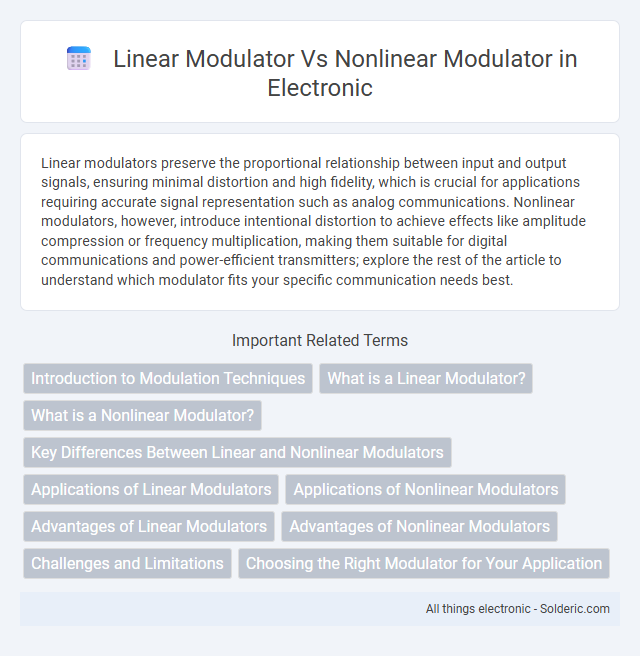Linear modulators preserve the proportional relationship between input and output signals, ensuring minimal distortion and high fidelity, which is crucial for applications requiring accurate signal representation such as analog communications. Nonlinear modulators, however, introduce intentional distortion to achieve effects like amplitude compression or frequency multiplication, making them suitable for digital communications and power-efficient transmitters; explore the rest of the article to understand which modulator fits your specific communication needs best.
Comparison Table
| Feature | Linear Modulator | Nonlinear Modulator |
|---|---|---|
| Signal Type | Amplitude and phase modulation with linear relationship | Signal modulation involving nonlinear response or characteristics |
| Linearity | Operates in the linear region to preserve signal integrity | Uses nonlinear effects, may distort signal but enhances efficiency |
| Application | Used in analog modulation systems, e.g., QAM, PSK | Common in power-efficient transmitters like Class C amplifiers |
| Efficiency | Lower efficiency due to linear amplification requirements | Higher efficiency from operating at saturation or switching states |
| Signal Distortion | Minimal distortion, suitable for high-fidelity signals | Higher distortion, requiring compensation techniques |
| Complexity | Higher circuit complexity and cost | Simpler circuit design, often lower cost |
| Examples | Linear amplifiers, linear phase modulators | Switching amplifiers, envelope modulators |
Introduction to Modulation Techniques
Linear modulators maintain a proportional relationship between the input and output signals, preserving amplitude and phase information essential for analog and digital communication systems. Nonlinear modulators, in contrast, introduce signal distortion to enhance power efficiency, commonly used in amplitude modulation schemes like AM and envelope detection. Understanding these modulation techniques helps you optimize signal transmission quality and system performance based on application needs.
What is a Linear Modulator?
A linear modulator is a device that alters a carrier signal's amplitude, frequency, or phase in direct proportion to the input signal, preserving the signal's waveform integrity for accurate transmission. This type of modulation is essential in applications requiring high fidelity and minimal distortion, such as analog communication systems and certain digital modulation schemes like QAM and QPSK. Understanding the function of a linear modulator helps you optimize your communication system for clarity and efficiency, especially when precise signal representation is critical.
What is a Nonlinear Modulator?
A nonlinear modulator is a device or circuit that alters a carrier signal by introducing nonlinear distortion components, often used in applications such as frequency multiplication or phase modulation. Unlike linear modulators which maintain a proportional relationship between input and output signals, nonlinear modulators produce harmonics and intermodulation products essential for complex modulation schemes like frequency modulation (FM) and angle modulation. These modulators are critical in wireless communication systems for efficiently generating higher frequency signals and improving spectral efficiency.
Key Differences Between Linear and Nonlinear Modulators
Linear modulators preserve signal integrity by maintaining a direct proportionality between input and output, ideal for applications requiring high fidelity and low distortion, such as analog communication and RF amplification. Nonlinear modulators, however, introduce intentional distortion or compression, making them suitable for digital modulation schemes like phase or frequency shift keying where signal amplitude variations are less critical. Understanding these key differences helps optimize your system's performance based on the modulation requirements and the nature of the transmitted signal.
Applications of Linear Modulators
Linear modulators are essential in applications requiring high-fidelity signal transmission, such as in advanced communication systems, radar, and satellite broadcasting. Their ability to maintain signal integrity and reduce distortion makes them ideal for digital data transmission and audio amplification tasks. Understanding how linear modulators enhance your system's performance can lead to more efficient and reliable communication solutions.
Applications of Nonlinear Modulators
Nonlinear modulators are essential in applications requiring high power efficiency and robustness, such as in power amplifiers for wireless communication and radar systems. They are widely utilized in nonlinear analog signal processing tasks, including frequency multiplication and envelope detection. These modulators excel in scenarios where signal distortion can be tolerated or compensated, enabling their use in energy-efficient transmitters and phase modulation schemes.
Advantages of Linear Modulators
Linear modulators offer superior signal fidelity by maintaining proportional amplitude and phase relationships, resulting in lower signal distortion and improved spectral efficiency. They enable precise amplitude modulation schemes such as QAM and OFDM, essential for high-data-rate communication systems. Reduced signal interference and better linearity make linear modulators ideal for advanced wireless and satellite communication applications.
Advantages of Nonlinear Modulators
Nonlinear modulators offer higher power efficiency and simpler design compared to linear modulators, making them ideal for battery-powered and portable communication devices. These modulators excel in handling signals with constant envelope modulation schemes, reducing signal distortion and improving transmitter longevity. Your communication system benefits from reduced energy consumption and enhanced performance in high-power applications.
Challenges and Limitations
Linear modulators face challenges such as limited efficiency and increased heat dissipation due to continuous signal variation, which restricts power handling and scalability in high-frequency applications. Nonlinear modulators, while more efficient, suffer from distortion and intermodulation products that degrade signal quality and require complex filtering techniques. Both types encounter trade-offs between linearity, efficiency, and complexity, impacting their suitability for specific communication systems.
Choosing the Right Modulator for Your Application
Selecting the right modulator depends on the specific requirements of your application, with linear modulators excelling in high-fidelity signal amplification and maintaining signal integrity for analog and complex digital signals. Nonlinear modulators provide higher efficiency and are ideal for applications where power conservation and simple modulation schemes, such as AM or FM, are critical. Understanding factors like signal linearity, power efficiency, and bandwidth needs ensures optimal modulator performance and system reliability.
Linear modulator vs nonlinear modulator Infographic

 solderic.com
solderic.com